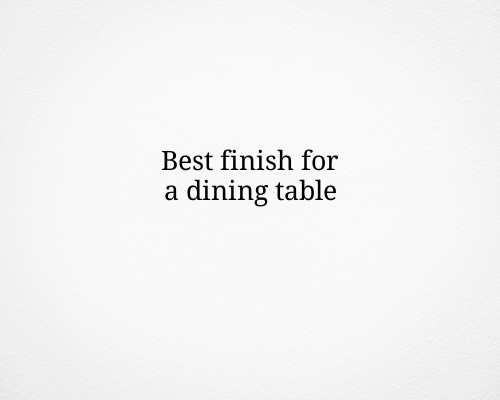Choosing the best finish for a dining table depends on several factors, including durability, ease of maintenance, and aesthetics. The most popular finishes for dining tables are polyurethane, oil-based finishes, and varnish. Here’s a breakdown of the best options:
Polyurethane Finish
- Durability: Polyurethane provides excellent protection against scratches, spills, and stains. It’s ideal for high-traffic areas like a dining table.
- Appearance: Polyurethane finishes can be glossy, semi-gloss, or satin, depending on your preference. It adds a sleek and smooth surface but can sometimes make the wood appear a bit “plastic” or unnatural.
- Ease of Application: It can be brushed or sprayed on, but requires multiple coats to achieve the desired result. Be sure to allow adequate drying time between coats.
- Maintenance: Very easy to clean with just a damp cloth, but it may require occasional touch-ups if it gets scratched or damaged.
- Best For: Families or homes with heavy use where durability is key.
Oil-based Finishes (e.g., Danish Oil, Tung Oil)
- Durability: While oil-based finishes penetrate the wood and enhance the natural look, they don’t provide the same level of surface protection as polyurethane. However, they still offer decent resistance to moisture and wear.
- Appearance: This type of finish gives wood a warm, natural look, accentuating the grain and color of the wood. It’s especially suited for tables made of fine hardwoods.
- Ease of Application: Easy to apply and reapply. However, it may require more frequent reapplication over time, especially in high-traffic areas.
- Maintenance: It requires regular maintenance, including re-oiling the surface to maintain its appearance and protection.
- Best For: Those looking for a natural finish that highlights the wood grain and is willing to do more upkeep.
Varnish
- Durability: Varnish is one of the most durable finishes available. It forms a hard, protective layer on the wood surface, protecting it from water, heat, and abrasions.
- Appearance: Varnish tends to give a high-gloss finish, although satin and matte options are available. It can sometimes be a bit too shiny for rustic or traditional looks.
- Ease of Application: Similar to polyurethane, varnish requires multiple coats and can be a bit tricky to apply without leaving streaks or brush marks.
- Maintenance: Very low maintenance once applied. It’s highly resistant to scratches and damage but can be harder to repair if it does get damaged.
- Best For: Those seeking maximum durability and a shiny finish.
Lacquer
- Durability: Lacquer finishes are highly durable and resistant to heat, moisture, and scratches. They form a tough, smooth surface.
- Appearance: Lacquer offers a very glossy finish that can give a high-end, modern look to a dining table.
- Ease of Application: Lacquer can be challenging to apply as it dries quickly and may require professional-grade spraying equipment.
- Maintenance: Very low maintenance, as lacquer is a strong, protective finish. However, repairs can be difficult.
- Best For: A highly polished, glossy finish with professional quality.
Shellac
- Durability: Shellac provides a soft, glossy finish that is more susceptible to damage from water, heat, and chemicals. It’s best suited for decorative purposes or low-use tables.
- Appearance: Shellac gives a warm, rich look to wood, but it’s not as durable as polyurethane or varnish.
- Ease of Application: Shellac is easy to apply with a brush or cloth, and it dries quickly.
- Maintenance: Frequent reapplication is needed if exposed to heavy use.
- Best For: A natural, warm finish that’s perfect for less-used tables or for antique restoration.
Conclusion:
For the best overall protection and ease of use, polyurethane is generally the most popular choice, particularly for a dining table that will see a lot of use. However, if you prefer a natural, organic look, oil-based finishes like Tung oil or Danish oil are great options, offering warmth and depth to the wood’s appearance.
